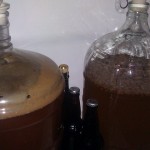I thought I would show you what was happening in the fridge downstairs.
Ok – so the Doppelbock that I brewed is on the left. It is day 11 of fermentation and it is just slowing down now. The airlock activity has been stronger for this brew than any other lager I have made this year (or any other year for that matter). It makes sense since the gravity is higher than the others. I guess I don’t know what’s going to happen with fermentations until they happen.
The plan is to take a reading on Sunday and see where the gravity is. If it is close to the target final gravity, then I’ll get a secondary carboy ready and start a just-in-case diacetyl rest.
Then it’s lagering time.
For your information, the carboy on the right is the New England Hard Cider that I made in the beginning of the month.
The stuff floating at the top of the carboy are chopped up raisins. There are some conflicting information about why raisins are added to hard cider. I read that they provide yeast nutrients, that they add yeast to the party, that they add tannins to the cider, and that they add a spicy flavor.
I really don’t know and I don’t care. I think that I am going to rack the cider away from the raisins and onto the oak spiral this weekend.


Jack
“If it is close to the target final gravity, then I’ll get a secondary carboy ready and start a just-in-case diacetyl rest.”
Don’t rack before starting your D-rest! When you rack to secondary, you leave much of the yeast behind, and that yeast is absolutely necessary for the D-rest, as its the yeast, itself, that re-absorbs the diacetyl that it produced during the growth phase. If you need to do a D-rest, allow your primary fermenter to come up to about 67-68F during the last 15-25% of fermentation, then crash-cool to get the yeast to flocculate, *then* keg or rack to secondary to start the lagering process.
John
Thanks Jack – I appreciate the comment. The intent of getting my secondary carboy ready – includes cleaning it and sanitizing it – is that I have a process that takes time. I usually let things soak overnight. The D rest happens with the beer in the primary – always.
Brian
I’ve tweaked your cider a bit by upping the honey, using dark brown sugar (1.063 initial with out any white sugar) and changing to a pilsen lager yeast…It’s been pretty active for the last 11 days fermenting between 55 and 62F (basement temps). I’m going to add the raisins this weekend and take a reading and a taste. My understanding is that the raisins are supposed to go in as things are slowing right? Some of what I was reading seemed to imply it should go in earlier. Then racking over oak in a secondary untill all the suspended yeast settles? There’s a lot of stuff suspended and not much settling considering the activity level of the ferment in the primary. Though I have to say the lock smells great. Thanks for a great blog.
John
Hey Brian,
Those are some good tweaks. I am wondering how the lager yeast will make the cider taste.
Yeah, I added the raisins when things were slowing down. It was probably week 3 of the primary fermentation. I decided to rack it to another vessel onto the raisins.
Racking the cider to another vessel will help to get some clarity. Racking again will help even more.
I plan to rack it again into another vessel and add the oak spiral.
Brian
Racked the cider to the secondary over the oak spirals…both floated on Sunday, one has since sunk…the gravity sample was tasty and very dry.
John
My spiral is still floating but I tasted a sample and I think the oak flavor is right where I want it. The clarity is fantastic as well. I am going to bottle tonight if I can get enough time to do it.